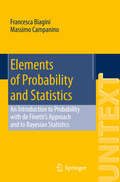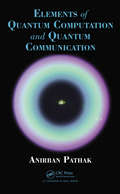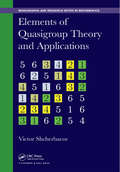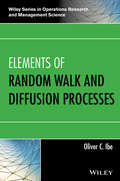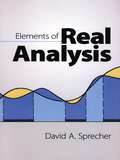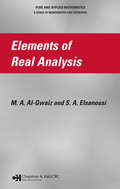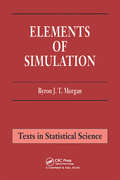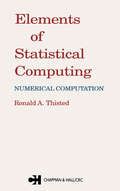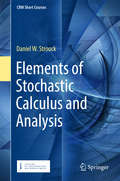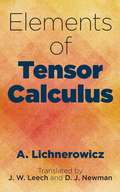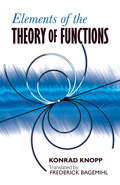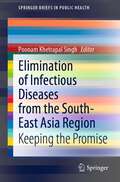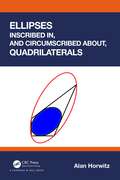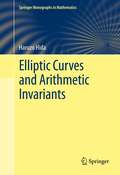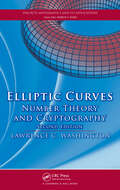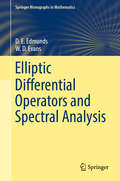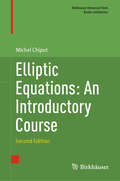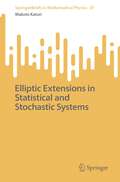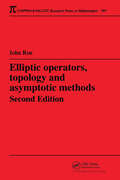- Table View
- List View
Elements of Probability and Statistics
by Francesca Biagini Massimo CampaninoThis bookprovides an introduction to elementary probability and to Bayesianstatistics using de Finetti's subjectivist approach. One of the featuresof this approach is that it does not require the introductionof sample space - a non-intrinsic concept that makes the treatment ofelementary probability unnecessarily complicate - but introduces asfundamental the concept of random numbers directly related to their interpretationin applications. Events become a particular case of random numbers andprobability a particular case of expectation when it is applied to events. The subjective evaluation of expectation and of conditional expectation isbased on an economic choice of an acceptable bet or penalty. Theproperties of expectation and conditional expectation are derived by applyinga coherence criterion that the evaluation has to follow. The book is suitablefor all introductory courses in probability and statistics for students inMathematics, Informatics, Engineering, and Physics.
Elements of Quantum Computation and Quantum Communication
by Anirban PathakWhile there are many available textbooks on quantum information theory, most are either too technical for beginners or not complete enough. Filling the gap, this book gives a clear, self-contained introduction to quantum computation and communication. Exploring recent developments and open questions in the field, it prepares readers for further study and helps them understand more advanced texts and journal papers. Along with thought-provoking cartoons and brief biographies of key players in the field, each chapter includes examples, references, exercises, and problems with detailed solutions.
Elements of Quasigroup Theory and Applications (Chapman & Hall/CRC Monographs and Research Notes in Mathematics)
by Victor ShcherbacovThis book provides an introduction to quasigroup theory along with new structural results on some of the quasigroup classes. Many results are presented with some of them from mathematicians of the former USSR. These included results have not been published before in the western mathematical literature. In addition, many of the achievements obtained with regard to applications of quasigroups in coding theory and cryptology are described.
Elements of Random Walk and Diffusion Processes
by Oliver C. IbePresents an important and unique introduction to random walk theoryRandom walk is a stochastic process that has proven to be a useful model in understanding discrete-state discrete-time processes across a wide spectrum of scientific disciplines. Elements of Random Walk and Diffusion Processes provides an interdisciplinary approach by including numerous practical examples and exercises with real-world applications in operations research, economics, engineering, and physics.Featuring an introduction to powerful and general techniques that are used in the application of physical and dynamic processes, the book presents the connections between diffusion equations and random motion. Standard methods and applications of Brownian motion are addressed in addition to Levy motion, which has become popular in random searches in a variety of fields. The book also covers fractional calculus and introduces percolation theory and its relationship to diffusion processes.With a strong emphasis on the relationship between random walk theory and diffusion processes, Elements of Random Walk and Diffusion Processes features:Basic concepts in probability, an overview of stochastic and fractional processes, and elements of graph theoryNumerous practical applications of random walk across various disciplines, including how to model stock prices and gambling, describe the statistical properties of genetic drift, and simplify the random movement of molecules in liquids and gasesExamples of the real-world applicability of random walk such as node movement and node failure in wireless networking, the size of the Web in computer science, and polymers in physicsPlentiful examples and exercises throughout that illustrate the solution of many practical problemsElements of Random Walk and Diffusion Processes is an ideal reference for researchers and professionals involved in operations research, economics, engineering, mathematics, and physics. The book is also an excellent textbook for upper-undergraduate and graduate level courses in probability and stochastic processes, stochastic models, random motion and Brownian theory, random walk theory, and diffusion process techniques.
Elements of Real Analysis
by David A. SprecherThis classic text in introductory analysis delineates and explores the intermediate steps between the basics of calculus and the ultimate stage of mathematics: abstraction and generalization.Since many abstractions and generalizations originate with the real line, the author has made it the unifying theme of the text, constructing the real number system from the point of view of a Cauchy sequence (a step which Dr. Sprecher feels is essential to learn what the real number system is).The material covered in Elements of Real Analysis should be accessible to those who have completed a course in calculus. To help give students a sound footing, Part One of the text reviews the fundamental concepts of sets and functions and the rational numbers. Part Two explores the real line in terms of the real number system, sequences and series of number and the structure of point sets. Part Three examines the functions of a real variable in terms of continuity, differentiability, spaces of continuous functions, measure and integration, and the Fourier series.An especially valuable feature of the book is the exercises which follow each section. There are over five hundred, ranging from the simple to the highly difficult, each focusing on a concept previously introduced.
Elements of Real Analysis (Chapman & Hall/CRC Pure and Applied Mathematics)
by M.A. Al-Gwaiz S.A. ElsanousiFocusing on one of the main pillars of mathematics, Elements of Real Analysis provides a solid foundation in analysis, stressing the importance of two elements. The first building block comprises analytical skills and structures needed for handling the basic notions of limits and continuity in a simple concrete setting while the second component in
Elements of Simulation (Chapman And Hall/crc Texts In Statistical Science Ser. #4)
by Byron J.T. MorganThe use of simulation in statistics dates from the start of the 20th century, coinciding with the beginnings of radio broadcasting and the invention of television. Just as radio and television are now commonplace in our everyday lives, simulation methods are now widely used throughout the many branches of statistics, as can be readily appreciated from reading Chapters 1 and 9. The book has grown out of a fifteen-hour lecture course given to third-year mathematics undergraduates at the University of Kent, and it could be used either as an undergraduate or a postgraduate text. Simulation may either be taught as an operational research tool in its own right, or as a mathematical method which cements together different parts of statistics and which may be used in a variety of lecture courses. In the last three chapters indications are made of the varied uses of simulation throughout statistics. Alternatively, simulation may be used to motivate subjects such as the teaching of distribution theory and the manipulation of random variables, and Chapters 4 and 5 especially will hopefully be useful in this respect.
Elements of Statistical Computing: NUMERICAL COMPUTATION
by R.A. ThistedStatistics and computing share many close relationships. Computing now permeates every aspect of statistics, from pure description to the development of statistical theory. At the same time, the computational methods used in statistical work span much of computer science. Elements of Statistical Computing covers the broad usage of computing in statistics. It provides a comprehensive account of the most important computational statistics. Included are discussions of numerical analysis, numerical integration, and smoothing.The author give special attention to floating point standards and numerical analysis; iterative methods for both linear and nonlinear equation, such as Gauss-Seidel method and successive over-relaxation; and computational methods for missing data, such as the EM algorithm. Also covered are new areas of interest, such as the Kalman filter, projection-pursuit methods, density estimation, and other computer-intensive techniques.
Elements of Stochastic Calculus and Analysis (Crm Short Courses Ser.)
by Daniel W. StroockThis book gives a somewhat unconventional introduction to stochastic analysis. Although most of the material coveredhere has appeared in other places, this book attempts to explain the core ideas on which that material is based. As a consequence, the presentation is more an extended mathematical essay than a ``definition,lemma, theorem'' text. In addition, it includes several topics that are not usually treated elsewhere. For example,Wiener's theory of homogeneous chaos is discussed, Stratovich integration is given a novel development and applied to derive Wong and Zakai's approximation theorem, and examples are given of the application ofMalliavin's calculus to partial differential equations. Each chapter concludes with several exercises, some of which are quite challenging. The book is intended for use by advanced graduate students and researchmathematicians who may be familiar with many of the topics but want to broaden their understanding of them.
Elements of Tensor Calculus (Dover Books on Mathematics)
by A. Lichnerowicz D. J. Newman J. W. LeechThis classic introductory text, geared toward undergraduate students of mathematics, is the work of an internationally renowned authority on tensor calculus. The two-part treatment offers a rigorous presentation of tensor calculus as a development of vector analysis as well as discussions of the most important applications of tensor calculus.Starting with a chapter on vector spaces, Part I explores affine Euclidean point spaces, tensor algebra, curvilinear coordinates in Euclidean space, and Riemannian spaces. Part II examines the use of tensors in classical analytical dynamics and details the role of tensors in special relativity theory. The book concludes with a brief presentation of the field equations of general relativity theory.
Elements of the Theory of Functions
by Konrad Knopp Frederick BagemihlThis well-known book provides a clear and concise review of general function theory via complex variables. Suitable for undergraduate math majors, the treatment explores only those topics that are simplest but are also most important for the development of the theory. Prerequisites include a knowledge of the foundations of real analysis and of the elements of analytic geometry.The text begins with an introduction to the system of complex numbers and their operations. Then the concept of sets of numbers, the limit concept, and closely related matters are extended to complex quantities. Final chapters examine the elementary functions, including rational and linear functions, exponential and trigonometric functions, and several others as well as their inverses, including the logarithm and the cyclometric functions. Numerous examples clarify the essential ideas, and proofs are expressed in a direct manner without sacrifice of completeness or rigor.
Elevate Science, Grade 1
by Michael J. Padilla Zipporah Miller Michael E. WysessionNIMAC-sourced textbook
Elimination of Infectious Diseases from the South-East Asia Region: Keeping the Promise (SpringerBriefs in Public Health)
by Poonam Khetrapal SinghThis book discusses the historical context, country experience, and best practices that led to eliminating infectious diseases from the WHO’s South-East Asia Region, such as malaria, lymphatic filariasis, yaws, trachoma, and mother-to-child HIV in the mid-twentieth and twenty-first century. The UN Sustainable Development Goals (3.3) targets to end AIDS, tuberculosis, malaria, and neglected tropical diseases and combat hepatitis, water-borne diseases and other communicable diseases by 2030. In this context, this book is of high significance to countries from the SEA region and around the globe. It helps create national strategies and action plans on infectious disease elimination and thus attaining SDG 3.3.
Ellipses Inscribed in, and Circumscribed about, Quadrilaterals
by Alan HorwitzThe main focus of this book is disseminating research results regarding the pencil of ellipses inscribing arbitrary convex quadrilaterals. In particular, the author proves that there is a unique ellipse of maximal area, EA, and a unique ellipse of minimal eccentricity, EI, inscribed in Q. Similar results are also proven for ellipses passing through the vertices of a convex quadrilateral along with some comparisons with inscribed ellipses. Special results are also given for parallelograms.Researchers in geometry and applied mathematics will find this unique book of interest. Software developers, image processors along with geometers, mathematicians, and statisticians will be very interested in this treatment of the subject of inscribing and circumscribing ellipses with the comprehensive treatment here.Most of the results in this book were proven by the author in several papers listed in the references at the end. This book gathers results in a unified treatment of the topics while also shortening and simplifying many of the proofs.This book also contains a separate section on algorithms for finding ellipses of maximal area or of minimal eccentricity inscribed in, or circumscribed about, a given quadrilateral and for certain other topics treated in this book.Anyone who has taken calculus and linear algebra and who has a basic understanding of ellipses will find it accessible.
Ellipsoidal Harmonics Theory and Applications
by George DassiosThe sphere is what might be called a perfect shape. Unfortunately nature is imperfect and many bodies are better represented by an ellipsoid. The theory of ellipsoidal harmonics, originated in the 19th century, could only be seriously applied with the kind of computational power available in recent years. This, therefore, is the first book devoted to ellipsoidal harmonics. Topics are drawn from geometry, physics, biosciences and inverse problems. It contains classical results as well as new material, including ellipsoidal bi-harmonic functions, the theory of images in ellipsoidal geometry and vector surface ellipsoidal harmonics, which exhibit an interesting analytical structure. Extended appendices provide everything one needs to solve formally boundary value problems. End-of-chapter problems complement the theory and test the reader's understanding. The book serves as a comprehensive reference for applied mathematicians, physicists, engineers and for anyone who needs to know the current state of the art in this fascinating subject.
Elliptic Curves and Arithmetic Invariants
by Haruzo HidaThis book contains a detailed account of the result of the author's recent Annals paper and JAMS paper on arithmetic invariant, including μ-invariant, L-invariant, and similar topics. This book can be regarded as an introductory text to the author's previous book p-Adic Automorphic Forms on Shimura Varieties. Written as a down-to-earth introduction to Shimura varieties, this text includes many examples and applications of the theory that provide motivation for the reader. Since it is limited to modular curves and the corresponding Shimura varieties, this book is not only a great resource for experts in the field, but it is also accessible to advanced graduate students studying number theory. Key topics include non-triviality of arithmetic invariants and special values of L-functions; elliptic curves over complex and p-adic fields; Hecke algebras; scheme theory; elliptic and modular curves over rings; and Shimura curves.
Elliptic Curves, Modular Forms and Iwasawa Theory
by David Loeffler Sarah Livia ZerbesCelebrating one of the leading figures in contemporary number theory - John H. Coates - on the occasion of his 70th birthday, this collection of contributions covers a range of topics in number theory, concentrating on the arithmetic of elliptic curves, modular forms, and Galois representations. Several of the contributions in this volume were presented at the conference Elliptic Curves, Modular Forms and Iwasawa Theory, held in honour of the 70th birthday of John Coates in Cambridge, March 25-27, 2015. The main unifying theme is Iwasawa theory, a field that John Coates himself has done much to create. This collection is indispensable reading for researchers in Iwasawa theory, and is interesting and valuable for those in many related fields.
Elliptic Curves: Number Theory and Cryptography, Second Edition (Discrete Mathematics and Its Applications)
by Lawrence C. WashingtonLike its bestselling predecessor, Elliptic Curves: Number Theory and Cryptography, Second Edition develops the theory of elliptic curves to provide a basis for both number theoretic and cryptographic applications. With additional exercises, this edition offers more comprehensive coverage of the fundamental theory, techniques, and application
Elliptic Differential Operators and Spectral Analysis (Springer Monographs in Mathematics)
by D. E. Edmunds W. D. EvansThis book deals with elliptic differential equations, providing the analytic background necessary for the treatment of associated spectral questions, and covering important topics previously scattered throughout the literature.Starting with the basics of elliptic operators and their naturally associated function spaces, the authors then proceed to cover various related topics of current and continuing importance. Particular attention is given to the characterisation of self-adjoint extensions of symmetric operators acting in a Hilbert space and, for elliptic operators, the realisation of such extensions in terms of boundary conditions. A good deal of material not previously available in book form, such as the treatment of the Schauder estimates, is included. Requiring only basic knowledge of measure theory and functional analysis, the book is accessible to graduate students and will be of interest to all researchers in partial differential equations. The reader will value its self-contained, thorough and unified presentation of the modern theory of elliptic operators.
Elliptic Equations: An Introductory Course (Birkhäuser Advanced Texts Basler Lehrbücher)
by Michel ChipotThe aim of this book is to introduce the reader to different topics of the theory of elliptic partial differential equations by avoiding technicalities and complicated refinements. Apart from the basic theory of equations in divergence form, it includes subjects as singular perturbations, homogenization, computations, asymptotic behavior of problems in cylinders, elliptic systems, nonlinear problems, regularity theory, Navier-Stokes systems, p-Laplace type operators, large solutions, and mountain pass techniques. Just a minimum on Sobolev spaces has been introduced and work on integration on the boundary has been carefully avoided to keep the reader attention focused on the beauty and variety of these issues. The chapters are relatively independent of each other and can be read or taught separately. Numerous results presented here are original, and have not been published elsewhere. The book will be of interest to graduate students and researchers specializing in partial differential equations.
Elliptic Extensions in Statistical and Stochastic Systems (SpringerBriefs in Mathematical Physics #47)
by Makoto KatoriHermite's theorem makes it known that there are three levels of mathematical frames in which a simple addition formula is valid. They are rational, q-analogue, and elliptic-analogue. Based on the addition formula and associated mathematical structures, productive studies have been carried out in the process of q-extension of the rational (classical) formulas in enumerative combinatorics, theory of special functions, representation theory, study of integrable systems, and so on. Originating from the paper by Date, Jimbo, Kuniba, Miwa, and Okado on the exactly solvable statistical mechanics models using the theta function identities (1987), the formulas obtained at the q-level are now extended to the elliptic level in many research fields in mathematics and theoretical physics. In the present monograph, the recent progress of the elliptic extensions in the study of statistical and stochastic models in equilibrium and nonequilibrium statistical mechanics and probability theory is shown. At the elliptic level, many special functions are used, including Jacobi's theta functions, Weierstrass elliptic functions, Jacobi's elliptic functions, and others. This monograph is not intended to be a handbook of mathematical formulas of these elliptic functions, however. Thus, use is made only of the theta function of a complex-valued argument and a real-valued nome, which is a simplified version of the four kinds of Jacobi's theta functions. Then, the seven systems of orthogonal theta functions, written using a polynomial of the argument multiplied by a single theta function, or pairs of such functions, can be defined. They were introduced by Rosengren and Schlosser (2006), in association with the seven irreducible reduced affine root systems. Using Rosengren and Schlosser's theta functions, non-colliding Brownian bridges on a one-dimensional torus and an interval are discussed, along with determinantal point processes on a two-dimensional torus. Their scaling limits are argued, and the infinite particle systems are derived. Such limit transitions will be regarded as the mathematical realizations of the thermodynamic or hydrodynamic limits that are central subjects of statistical mechanics.
Elliptic Functions
by J. V. Armitage the late W. F. EberleinIn its first six chapters this 2006 text seeks to present the basic ideas and properties of the Jacobi elliptic functions as an historical essay, an attempt to answer the fascinating question: 'what would the treatment of elliptic functions have been like if Abel had developed the ideas, rather than Jacobi?' Accordingly, it is based on the idea of inverting integrals which arise in the theory of differential equations and, in particular, the differential equation that describes the motion of a simple pendulum. The later chapters present a more conventional approach to the Weierstrass functions and to elliptic integrals, and then the reader is introduced to the richly varied applications of the elliptic and related functions. Applications spanning arithmetic (solution of the general quintic, the functional equation of the Riemann zeta function), dynamics (orbits, Euler's equations, Green's functions), and also probability and statistics, are discussed.
Elliptic Operators, Topology, and Asymptotic Methods (Chapman & Hall/CRC Research Notes in Mathematics Series)
by John RoeTen years after publication of the popular first edition of this volume, the index theorem continues to stand as a central result of modern mathematics-one of the most important foci for the interaction of topology, geometry, and analysis. Retaining its concise presentation but offering streamlined analyses and expanded coverage of important exampl
Elliptic Polynomials
by J.S. Lomont John BrillhartA remarkable interplay exists between the fields of elliptic functions and orthogonal polynomials. In the first monograph to explore their connections, Elliptic Polynomials combines these two areas of study, leading to an interesting development of some basic aspects of each. It presents new material about various classes of polynomials and about t
Elliptic Quantum Groups: Representations and Related Geometry (SpringerBriefs in Mathematical Physics #37)
by Hitoshi KonnoThis is the first book on elliptic quantum groups, i.e., quantum groups associated to elliptic solutions of the Yang-Baxter equation. Based on research by the author and his collaborators, the book presents a comprehensive survey on the subject including a brief history of formulations and applications, a detailed formulation of the elliptic quantum group in the Drinfeld realization, explicit construction of both finite and infinite-dimensional representations, and a construction of the vertex operators as intertwining operators of these representations. The vertex operators are important objects in representation theory of quantum groups. In this book, they are used to derive the elliptic q-KZ equations and their elliptic hypergeometric integral solutions. In particular, the so-called elliptic weight functions appear in such solutions. The author’s recent study showed that these elliptic weight functions are identified with Okounkov’s elliptic stable envelopes for certain equivariant elliptic cohomology and play an important role to construct geometric representations of elliptic quantum groups. Okounkov’s geometric approach to quantum integrable systems is a rapidly growing topic in mathematical physics related to the Bethe ansatz, the Alday-Gaiotto-Tachikawa correspondence between 4D SUSY gauge theories and the CFT’s, and the Nekrasov-Shatashvili correspondences between quantum integrable systems and quantum cohomology. To invite the reader to such topics is one of the aims of this book.
